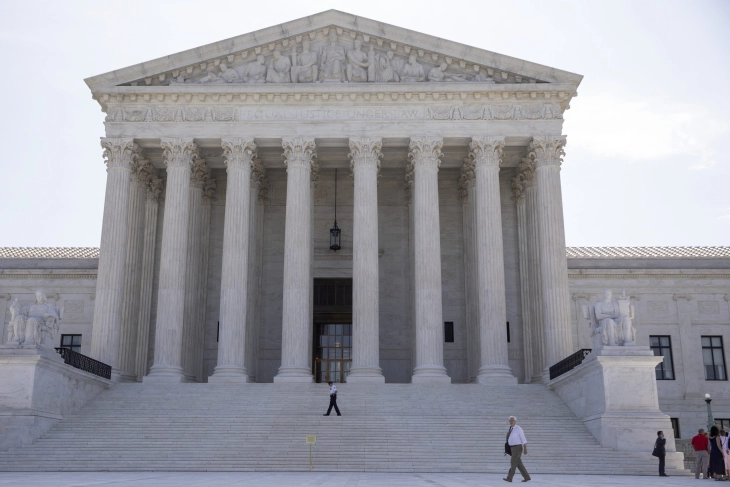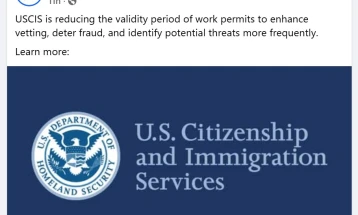In historic reversal, US Supreme Court frees states to ban abortions
- Post By Ivan Kolekevski
- 16:31, 24 June, 2022

Washington, 24 June 2022 (dpa/MIA) - In a historic reversal, the US Supreme Court on Friday overturned the landmark 1973 Roe vs. Wade decision and ruled states may again outlaw abortion.
The court’s conservative majority said the Constitution does not protect the rights of women to choose abortion, and instead leaves these decisions in the hands of state lawmakers.
The 5-4 ruling marks the most significant curtailing of an established constitutional right in the court’s history.
The opinion written by Justice Samuel A. Alito Jr. closely tracks a draft which was leaked by Politico in May.
“We hold that Roe and [the 1992 Planned Parenthood vs.] Casey must be overruled,” Alito wrote. “The Constitution makes no reference to abortion, and no such right is implicitly protected by any constitutional provision, including the one on which the defenders of Roe and Casey now chiefly rely—the Due Process Clause of the 14th Amendment.”
The opinion was joined by Justices Clarence Thomas, Neil M. Gorsuch, Brett M. Kavanaugh and Amy Coney Barrett.
Chief Justice John G. Roberts Jr. concurred, but did not join the majority opinion, saying he would have only upheld a Mississippi 15-week ban on abortion and stopped short of overturning Roe.
“The court’s decision to overrule Roe and Casey is a serious jolt to the legal system,” Roberts wrote.
The court’s three liberal justices — Justice Stephen Breyer, Sonia Sotomayor and Elena Kagan — dissented.
“Today, the court ...says that from the very moment of fertilization, a woman has no rights to speak of,” their dissent read. “A state can force her to bring a pregnancy to term, even at the steepest personal and familial costs.”
The dissenting justices concluded, “Whatever the exact scope of the coming laws, one result of today’s decision is certain: the curtailment of women’s rights, and of their status as free and equal citizens.”
The ruling figures to set off a fierce political fight nationwide and state-by-state as politicians and voters weigh in on whether abortion should be restricted or prohibited entirely.
Opinion polls show most Americans support access to abortion, at least in the early months of a pregnancy. Nevertheless half the states are expected to seek to quickly enforce laws that make most abortions illegal.
The decision is the high court’s most far-reaching reversal on a matter of constitutional rights since 1954, when the justices reversed six decades of precedent and struck down laws authorizing racial segregation.
But that unanimous decision in Brown vs. Board of Education expanded the rights of individuals and rejected conservative state laws, while today’s does the opposite. It empowers states and reverses what had been the most significant women’s rights ruling in the court’s history.
For the U.S. Catholic bishops as well as evangelical Christians who believe abortion ends a human life and is immoral, the ruling is a triumph decades in the making. They had refused to accept the idea the Constitution protected abortion as a fundamental right.
The decision also reflects a profound change within the court and the Republican Party.
When court handed down the Roe vs. Wade ruling in 1973 and voided the abortion bans that were in effect in nearly all the states, the 7-2 majority included five Republican appointees. In 1992, when a divided court upheld the right to abortion, the five justices in the majority were Republican appointees.
But in recent decades, Republican presidents promised to select new justices who would overturn Roe vs. Wade.
With the help of Senate Republican leader Mitch McConnell, President Trump appointed three new justices who made the difference. The death of Justice Ruth Bader Ginsburg in September of 2020 cleared the way for McConnell and his Republican majority to confirm Justice Amy Coney Barrett a week before Trump was defeated in the November election. Her vote proved crucial to the outcome.
It is rare for the court to make such an abrupt turn so quickly and on such a great constitutional question. The prospect for a major change on abortion first became apparent in the summer of 2018.
Justice Anthony M. Kennedy, a likely swing vote on abortion, announced his retirement at age 82, clearing the way for Trump to appoint Kennedy’s former clerk, Judge Brett M. Kavanaugh. After a fierce fight in the Senate, Kavanaugh was confirmed on a party-line vote.
Republican state attorneys saw an opening to change the law. In June 2020, Mississippi’s Attorney General Lynn Fitch urged the court to review a proposed state law that limited abortions to 15 weeks of a pregnancy.
The justices were set to consider the appeal in Dobbs vs. Jackson Women’s Health Organization at their first conference of the new term on September 29, 2020. But on Sept. 18, Ginsburg, the court’s senior liberal, died after a long battle with cancer.
Four days later, the Mississippi appeal was “rescheduled” for a future conference and on May 17, 2021, they announced they would hear the case and decide “whether all pre-viability prohibitions on elective abortions were unconstitutional.”
When the high court heard arguments in December, only Chief Justice John G. Roberts Jr. focused on the 15-week limit, the question the court had agreed to decide.
The five on his right—Justices Thomas, Alito, Gorsuch, Kavanaugh and Barrett—were ready to go further and repeal the right to abortion.
As impactful as it was, the Roe ruling was always built on a shaky legal foundation that left it vulnerable to reversal. Even the liberal lion Ginsburg, before she joined the court, had complained the sweeping decision attempted to move the nation too far, too fast, and should have had a clearer grounding in the Constitution.







